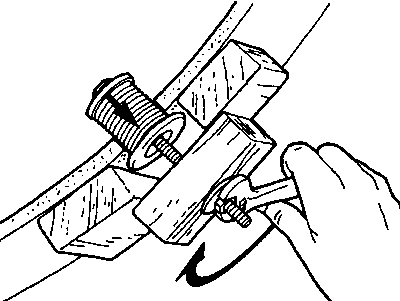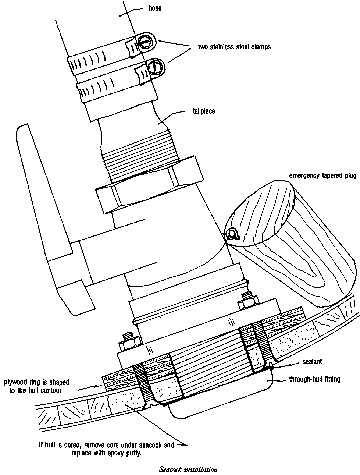Advertisement

My best advice for anyone contemplating adding a through-hull fitting is don't. Through-hulls sink boats. If you can accomplish the same thing by installing a tee-connector in an existing inlet or discharge line, you avoid boring another hole in the bottom of your boat. Having said that, I acknowledge that there are times when an additional through-hull fitting is the better of bad options.
The instructions that follow assume that the boat is out of the water. A helper will be needed.
New Through-Hull
Installing a new through-hull fitting necessitates a new hole in the hull. Always locate seacocks where they are readily accessible or you defeat the purpose of having a valve in the line. Before you drill the hole, double-check the location carefully both inside and outside the hull to make sure, for example, that inside there will be ample room to throw the handle, and outside the new fitting is not going to set up turbulence in front of your depth sounder or speed log impeller. From inside the hull, drill a small pilot hole and check the location one more time.
Select a hole saw the size of the fitting you are installing and cut the required hole by first drilling from the outside of the hull until the pilot drill in the hole saw penetrates the hull, then finish the hole by drilling from the inside. Clean up the edges of the hole with emery cloth.
If the hull is cored, dig out the core around the hole to hollow an area at least as large as the flange of the seacock you are installing. Fill the hollow area with epoxy putty and allow it to fully harden before proceeding. The epoxy provides a solid base for the through-hull and prevents water from reaching the core material.
Through-Hull Replacement
To replace a through-hull fitting, remove the nuts from the bolts through the seacock's mounting flange and unscrew the bolts or drive them out with a hammer and a punch. Unscrew the seacock from the through-hull-with the help of a pipe wrench, if necessary.

Through-hull fittings installed with polyurethane sealant can be very difficult to remove. A length of 3/8-inch threaded rod (or a long bolt) will make the job easier. Slide a washer or a metal plate too big to pass through the fitting onto the rod and capture it with a nut. Pass the rod through the fitting from inside the boat, seating the washer flat on the fitting. Outside the hull, pass the threaded rod through a hole drilled in a short length of 2 X 4 and fit the second washer and the nut. Support the length of wood on both sides of the fitting with a couple of wooden blocks. Now tighten the nut and the rod will pull the fitting from the hull.
Scrape away all sealant residue and wipe the area around the hole — both inside and outside the hull — with acetone. If you discover exposed core around the hole, replace it with epoxy putty as described above.
Dry-Fit
Once the hole is prepared, the remaining steps are identical for a new seacock or a replacement. Cut a circle of 3/4-inch plywood 2 or 3 inches larger than the flange of the seacock, and bore out the center with your hole saw to form a ring. Shape the bottom of this ring with a rasp or sander to match the inside curvature of the hull around the hole. The ring serves to reinforce the hull around the hole and to provide a flat surface for the seacock flange. Mark it so you can orient it correctly later.
Because you are going to thread the through-hull into the seacock, you can discard the lock nut. Insert the new through-hull fitting from outside the hull, then inside slip the wooden ring in place and thread the seacock onto the through-hull. The seacock and the through-hull fitting must always be the same material. Never attempt to install a nylon seacock on a bronze through-hull, nor a bronze seacock on a nylon through-hull.
Tighten the two parts together. Most boatyards have a special step-wrench that grips the ears inside bronze through-hulls. A wedge of scrap hardwood will do the same job. Grip the slots in nylon through-hulls with crossed screwdrivers.
With the seacock tightened snugly — not too tight — you should have plenty of threads inside the seacock, but the length of the through-hull should not prevent the base of the seacock from tightening against the plywood ring. If the through-hull is too short, replace the 3/4-inch thick ring with a new one cut and shaped from 1/2-inch plywood. If it is too long, add an additional ring cut from 1/4-inch plywood. Ideally, the through-hull should be just short of bottoming out inside the seacock.
Position the seacock the way you want it and make sure you can turn the handle without scraping knuckles. If it has a drain plug, try to orient the plug on the low side of the valve. Once satisfied with the position, drill mounting holes through the hull from inside the boat, using the holes in the mounting flange as a drill guide. If the flange is not pre-drilled, drill three evenly spaced holes through the flange and the hull. From outside the hull, countersink the three holes.
Unscrew the seacock and remove the through-hull fitting. Give the plywood rings 2 or 3 coats of epoxy (preferred) or varnish before completing the installation. Seacocks often weep enough to turn unprotected backer blocks to the consistency of damp toilet tissue, so do not skip this step.
Installation
Insert the through-hull, put the plywood ring(s) in position, and insert the mounting bolts through the hull and far enough into the plywood to prevent it from turning. If the seacock is bronze, the mounting bolts must also be bronze. Either stainless steel or bronze bolts may be used to mount nylon seacocks.

Tighten the seacock until it seats snugly on the ring and the mounting holes are in alignment. Remove the mounting bolts and heavily coat them for an inch or so below the heads with polyurethane sealant. Reinsert them through hull, ring, and flange, and install a washer and a nut on each. Tighten the nuts, but don't try out your Wheaties on them; bronze bolts in particular will stretch if you crank them too tight.
Unscrew the through-hull fitting and wipe it and the hole with acetone. Put a heavy bead of polyurethane (preferred) or polysulfide sealant around the shoulder of the through-hull, and lightly coat the threads. Reinsert the fitting and tighten it until it is quite snug. Sealant should squeeze out around its full perimeter. Use some of the excess sealant to fair over the heads of the screws. Pick up the rest with a scraper or the blade of a screwdriver.
To put the new seacock into service, fit it with a tailpiece (using thread sealant) and attach the appropriate hose. Don't forget to use dual clamps on all hose-to-seacock connections.
